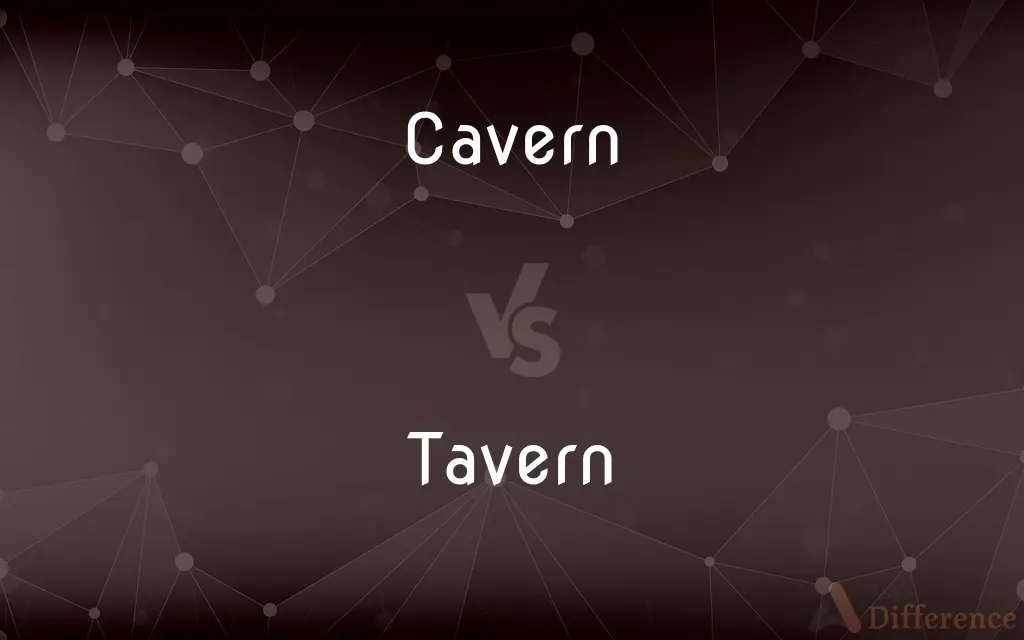Cavern vs. Tavern — What's the Difference?
By Tayyaba Rehman & Maham Liaqat — Updated on March 30, 2024
A cavern is a large underground chamber formed naturally, used to describe geological formations, whereas a tavern is an establishment serving food and drinks, often historically a place for lodging.

Difference Between Cavern and Tavern
Table of Contents
ADVERTISEMENT
Key Differences
Caverns are naturally occurring spaces within the earth, large enough for a human to enter, often found in limestone areas and formed by erosion. On the other hand, taverns are businesses that provide food and drink to customers, and historically, they also offered lodging to travelers. The primary function of caverns is as geological or natural formations with potential for exploration or scientific study, whereas taverns serve a social and economic role in communities.
While caverns can be ancient, with some being used by humans for shelter or ceremonial purposes historically, taverns have been central to social life in many cultures, offering a place for community gatherings, information exchange, and rest for weary travelers. Caverns are characterized by their physical features, such as stalactites and stalagmites, depth, and the presence of underground water sources, while taverns are known for their hospitality, ambiance, and the quality of their food and drink.
Exploration and scientific research are often associated with caverns, attracting spelunkers and geologists interested in their formation, ecology, and history. Conversely, taverns attract patrons looking for leisure, sustenance, and social interaction, playing a significant role in the cultural and economic fabric of a community.
The distinction between caverns and taverns highlights the difference between natural formations and human-made establishments, each with its own significance and role in human experience. While caverns offer a glimpse into the earth's geological past and natural beauty, taverns provide a space for human connection, refreshment, and tradition.
Comparison Chart
Definition
A large, naturally formed underground chamber.
An establishment serving food and drinks, sometimes offering lodging.
ADVERTISEMENT
Primary Function
Geological exploration, scientific study.
Hospitality, serving food and drinks.
Historical Use
Shelter, ceremonies.
Community gatherings, traveler lodging.
Key Features
Stalactites, stalagmites, underground water.
Food and drink menu, ambiance.
Role
Natural formation and exploration.
Social and economic community center.
Compare with Definitions
Cavern
Formed by natural processes.
This cavern was formed by water eroding the limestone.
Tavern
Historically offered lodging.
The old tavern has been lodging travelers since the 1700s.
Cavern
Can be used for exploration.
The cavern is a popular site for spelunking enthusiasts.
Tavern
A place serving food and drinks.
They stopped at a tavern for dinner.
Cavern
A site for scientific study.
Scientists study the cavern's unique ecosystem.
Tavern
A social gathering place.
The local tavern is the town's favorite meeting spot.
Cavern
Often found in limestone regions.
The area is known for its extensive limestone caverns.
Tavern
Offers a cozy ambiance.
The tavern's warm ambiance attracts many during the winter.
Cavern
A large underground chamber.
The explorers discovered a cavern filled with ancient paintings.
Tavern
Plays a role in community life.
The tavern hosts a weekly music night for locals.
Cavern
A large cave or chamber in a cave.
Tavern
A tavern is a place of business where people gather to drink alcoholic beverages and be served food, and (mostly historically) where travelers would receive lodging. An inn is a tavern that has a license to put up guests as lodgers.
Cavern
A large cave.
Tavern
An inn or public house.
Cavern
A large underground chamber, as in a cave.
Tavern
A place of business that serves alcoholic beverages and often basic meals.
Cavern
To enclose in or as if in a cavern.
Tavern
An inn for travelers.
Cavern
To hollow out.
Tavern
(dated) A building containing a bar licensed to sell alcoholic drinks, and usually offering accommodation.
Cavern
A large cave.
Tavern
A public house where travelers and other transient guests are accomodated with rooms and meals; an inn; a hotel; especially, in modern times, a public house licensed to sell liquor in small quantities.
Cavern
An underground chamber.
Tavern
A building with a bar that is licensed to sell alcoholic drinks
Cavern
A large, dark place or space.
A dark cavern of a shop
Cavern
(transitive) To form a cavern or deep depression in.
Catacombs caverning the hillsides
Cavern
(transitive) To put into a cavern.
Cavern
A large, deep, hollow place in the earth; a large cave.
Cavern
Any large dark enclosed space;
His eyes were dark caverns
Cavern
A large cave or a large chamber in a cave
Cavern
Hollow out as if making a cavern
Common Curiosities
What defines a tavern?
A tavern is an establishment that serves food and drinks, sometimes providing lodging.
How are caverns formed?
Caverns are often formed by the erosion of limestone by water.
Can you visit a cavern?
Yes, many caverns are open for exploration and scientific study.
What historical role did taverns play?
Historically, taverns served as key places for social gatherings, information exchange, and lodging for travelers.
What services do taverns offer?
Taverns offer food and drink services, and historically, lodging.
What kind of research is conducted in caverns?
Research in caverns can include geological studies, archaeology, and biology.
How do taverns contribute to community life?
Taverns serve as social centers where people gather for meals, drinks, and events.
Are there famous caverns?
Yes, there are many famous caverns worldwide, known for their size, beauty, or unique geological features.
What is a cavern?
A cavern is a large, naturally occurring underground chamber.
Are all caverns naturally occurring?
Yes, caverns are naturally formed underground chambers.
Can caverns be dangerous?
Exploring caverns can be dangerous without proper equipment and experience due to risks like falls, flooding, and getting lost.
What is the significance of taverns in history?
Taverns have been important in historical social life, serving as places for news dissemination, political meetings, and community bonding.
What makes a tavern different from a restaurant?
Taverns traditionally offered lodging and served as a social hub in addition to serving food and drinks.
What are stalactites and stalagmites?
Stalactites hang from the ceiling of a cavern, while stalagmites rise from the floor, often formed by dripping water rich in minerals.
How has the role of taverns evolved over time?
While modern taverns primarily focus on food and drinks, historically, they played a broader role in offering lodging and serving as community gathering spots.
Share Your Discovery

Previous Comparison
Environment vs. Context
Next Comparison
Basket vs. HamperAuthor Spotlight
Written by
Tayyaba RehmanTayyaba Rehman is a distinguished writer, currently serving as a primary contributor to askdifference.com. As a researcher in semantics and etymology, Tayyaba's passion for the complexity of languages and their distinctions has found a perfect home on the platform. Tayyaba delves into the intricacies of language, distinguishing between commonly confused words and phrases, thereby providing clarity for readers worldwide.
Co-written by
Maham Liaqat













































